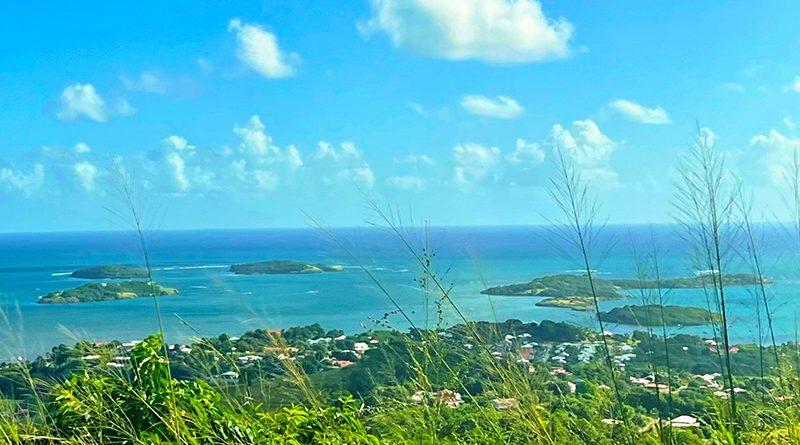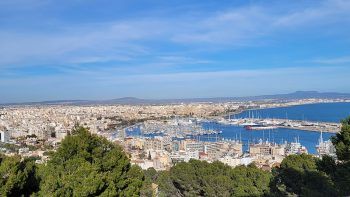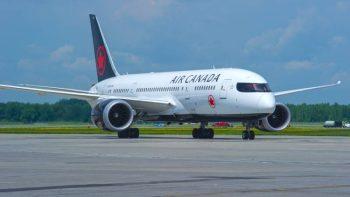Caribbean Warmth With a Modern French Flair: The Considerable Joys of Martinique
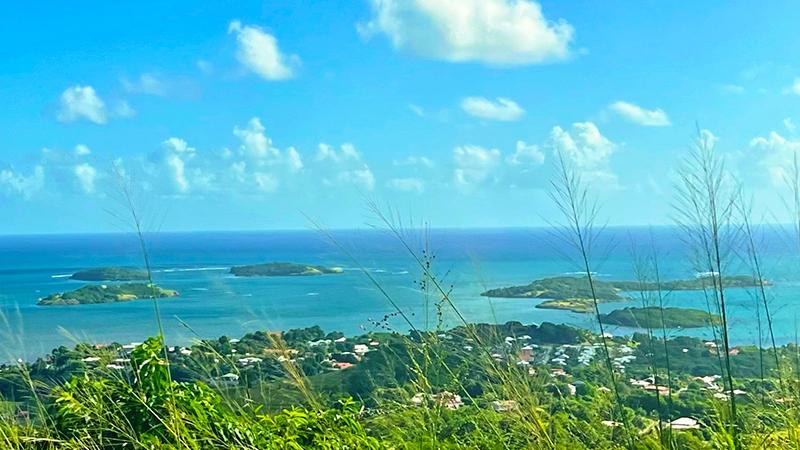
It was startling to hear.
I was having a look at the array of rums for sale at Depaz Distillery in northern Martinique when someone reached over my shoulder to grab a bottle.
“Sorry,” he said.
I was taken aback for a minute. Other than talking to members of our small travel writers’ group and our tour guides, it was the first word of English I had heard in more than 24 hours on the island.
Many people in the hospitality industry in Martinique speak English, but you know you’re in a different part of the Caribbean when you visit here. For one, it’s actually part of France. They also use Euros, have mostly French-style electrical outlets, and offer up wonderful, proper croissants that taste like flaky layers of buttery goodness.
Quebecers have been flying here regularly for years, but Air Canada on 16DEC will start offering this slice of tropical France to customers departing from YYZ, with a weekly flight on Saturdays running until 31MAR 2024.
Several workers in the tourism business here, including the beachfront Club Med Buccaneer’s Creek (Les Boucaniers en Francais), told Open Jaw they’re excited about welcoming flights from Toronto.
“It opens a new market for us, and it’s a chance to practise my English,” one Club Med worker said with a a warm smile.
Having arrived only 13NOV at 4 p.m. at the resort, your Open Jaw correspondent hasn’t had time to explore all of the island. But Club Med did arrange for an English-speaking guide with Top Tours Antilles to give us a full-day tour that provided a nice overview of a beautiful island with considerable French-Caribbean charm, right up-to-date medical care, excellent roads and marvelous nature all around.
We’ll get to Club Med later. For now, here are some highlights that advisors can use to tempt clients into trying a Caribbean holiday in La Martinique.
A COOLING WATERFALL
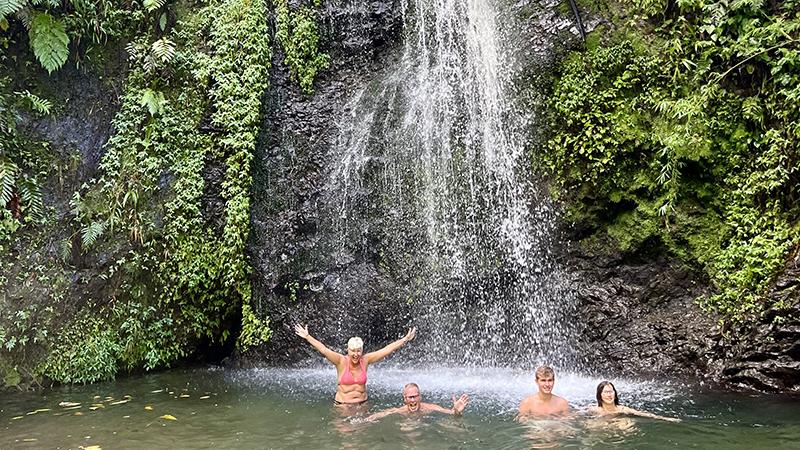
Our Top Tour Antilles guide, the engaging and knowledgeable Marius Andrew, told us his company can’t take big groups down the narrow, winding road that leads to Saut Gendarme. “But if it’s a small group and they’re kind people, I’ll take them.” It’s a two-minute walk from the road to the waterfall that requires navigating a short, steep staircase and a walk across some stones to cross a creek that’s probably not even two meters across. The water spills over a wide span of dark, volcanic rock amid an ocean of deep green foliage and spills into a large pool. The water was cool enough to be refreshing on a hot November day, but not remotely cold.
GOING BANANAS FOR MARTINIQUE
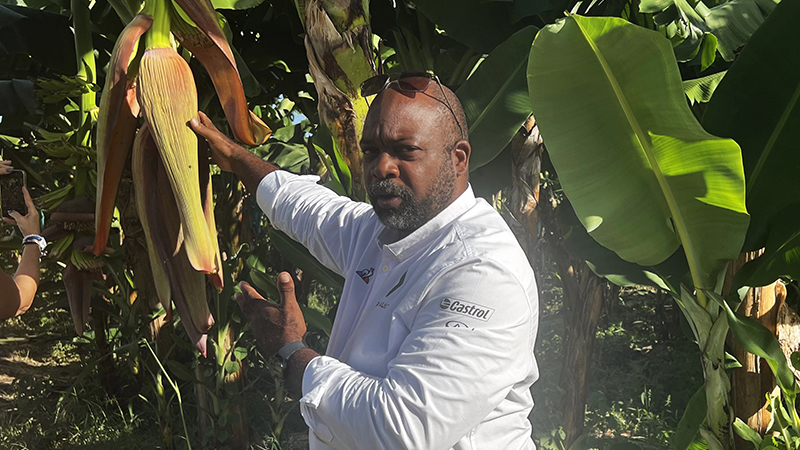
As we head northeast from the dry, southern tip of the island where Club Med is located, we pass rolling, folded hills, and velvety, deep valleys dotted with white-painted homes and small farms. As we approach the coast, Andrew tells us that agriculture, not tourism, is the main source of income for Martinique. The biggest crop are bananas, mostly a variety called Cavendish. Almost all are shipped to France or other European countries.
We stop at the edge of a plantation so Andrew can explain how bananas grow (quite rapidly) and are covered with plastic bags to keep out pests and speed the ripening process. “Small, green ones taste a little like an apple. We treat those as a vegetable. The yellow ones we treat as a fruit.” All the bananas are picked by hand by both men and women, and bunches to be carried can way more than 50 kg. Andrew also tells us banana trees (technically an herb, not a tree) can be used to produce cosmetics, and that the bark can be made into paper. As we drive, Andrew points out large breadfruit trees, papaya trees and bright, tropical flora in a country often called “The Island of Flowers.”
A BATH FIT FOR A RULER’S WIFE
Andrew drives up into the hills near Le Francois on the coast and points to a series of small, green islands hovering in the deep, blue Atlantic Ocean. “If you look in that channel right there, you’ll see some beautiful water. That’s called the Bath of Josephine,” which is named for the Martinique-born woman who became the wife of Napoleon Bonaparte. Off in the distance he points out a small speck of pale-coloured land; a sandbar with a solitary coconut tree. It looks inviting but it’s a turtle sanctuary that we humans aren’t allowed to visit.
A SPICY STOP
From Le Francois we made our way into the surprisingly busy capital, Fort-de-France, where we stop at a shop called World of Spices (Monde des Epices). It’s a lovely place that’s crammed with bags and bags of local spices, as well as balsamic vinegars, Martinique rhum, bars of nougat, Martinique coffee, locally made chocolate, tea, vanilla and more. Andrew shows off local cinnamon and bay leaf for us to sniff and explains how to use local spices.
Bucane is a mix you mix with oil for tasty marinated chicken, while Colombo is a popular curry-like mix that was brought to Guadeloupe and Martinique by indentured workers from India in the 18th and 19th centuries. Before we leave, we get a taste of rich, dark chocolate and a cup of espresso for a nice, mid-morning pick me up.
A MOUNTAIN CHURCH
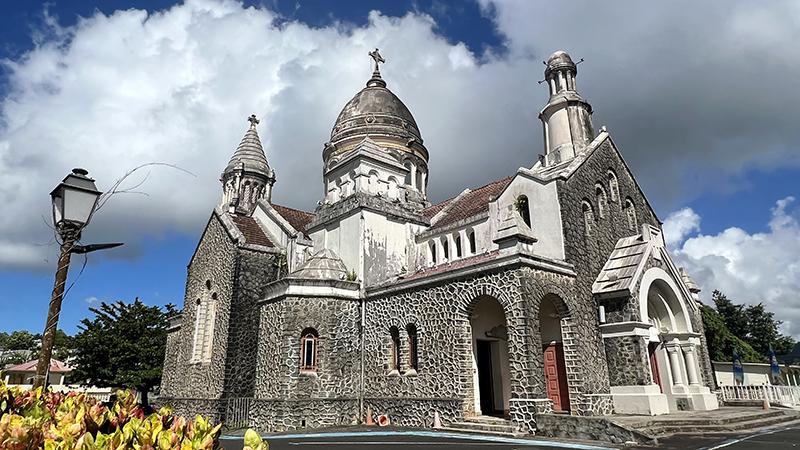
We drive high into the mountains above Fort-de-France and stop at the Sacre Coeur de Balata, a lovely church that resembles its better-known cousin in Paris. Built between 1923 and 1925, it’s sometimes called “The Montmartre Martiniquais.” It’s got a handsome interior that needs some TLC, with a domed ceiling and was built by two architects from Paris. I read later that the church is seeking donations for repairs.
A STUNNING MOUNTAIN GARDEN
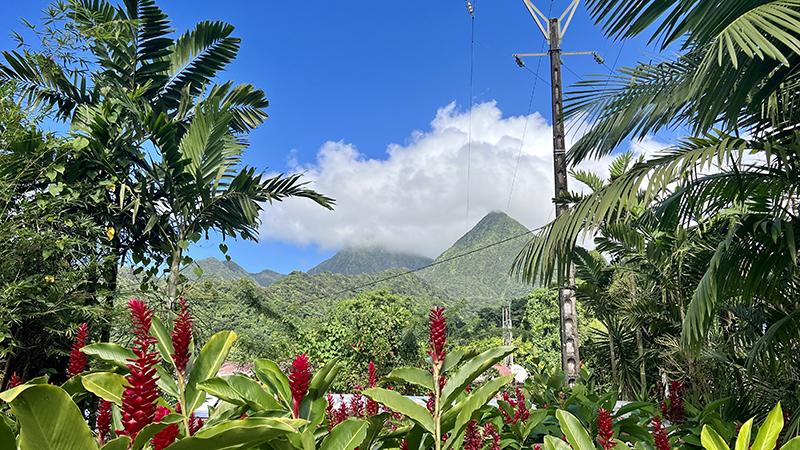
The Balata Gardens are one of the most popular attractions on Martinique, a large affair that boasts a pretty, Creole-style house and acre upon acre of winding paths lined with fiery, red alpinia flowers, rainbow-coloured heliconia, and towering bamboo. “The owner only added plants that gave him the right vibration,” Andrew tells us. Outside the Creole house, tiny, dark hummingbirds with iridescent green chest markings flutter around three bird feeders. Andrew tells me they’re called Coulibri and can fly both forward and backward. In addition to fabulous flowers (roughly 300 species) there are a series of narrow suspension bridges you can take for a Coulibri’s eye view of the grounds. I don’t like heights, but I manage to cross all the bridges with minimal heart palpitations.
LUNCH TIME
We take our lunch at Le Bambou, an expanding family spot near Balata Gardens. After a welcoming rum punch, we dive into small salads and hot cod fritters, a Martinique favourite. The main course comes with tuna and chicken cooked with rich, Colombo spices, sweet potato and yellow rice. Dessert is a showy bit of work with rum-soaked Martinique bananas flambe and a silky coconut flan. Outside the restaurant, Andrew shows us a garden filled with guava trees, lemongrass, thyme, cinnamon and massive avocado trees. I’m in Martinique, but the avocados have me dreaming of a big bowl of guacamole.
A LESSON IN RHUM AGRICOLE
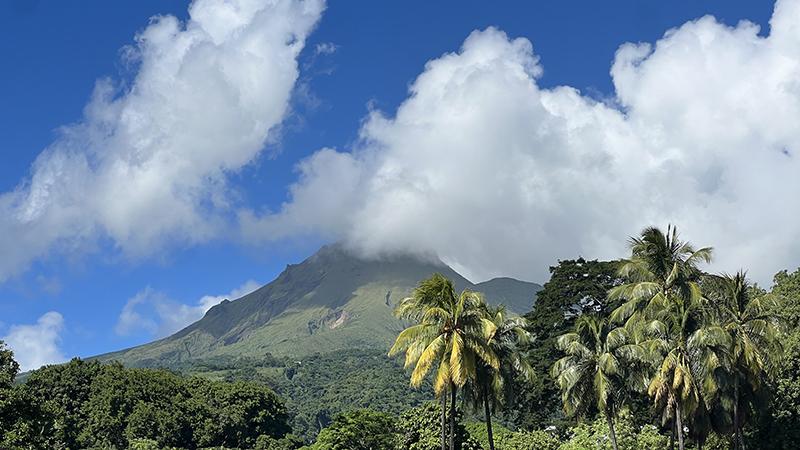
One of our late stops is at Depaz Distillery, which sits high on a hill below Mt. Pelee (recently designated a UNESCO world heritage site, the third one on Martinique). It’s a pretty spot with an open-air restaurant with nice views of the Caribbean, perhaps two km’s in the distance. Mt. Pelee erupted in 1902, sending plumes of thick, poisonous gas swiftly down the hill. Andrew told us it instantly killed some 28,000-30,000 residents of the nearby seaside village of Saint-Pierre (more on that in a second). It also wiped out the Depaz distillery and members of the family. But young Victor Depaz was studying in France at the time and escaped the fate that befell his family. Andrew tells us he returned 15 years later and rebuilt. Prior to a brief tasting, Andrew points out information panels that illustrate how Martinique makes rhum agricole. Unlike rum made from molasses, rhum agricole is made with pure sugar cane juice. Martinique residents say this is the purest way of making rum. It takes a bit of getting used to, as it has an herbal, almost grassy flavour to it and is not as sweet on the palette as the rums most of us are used to drinking. We later took a rhum tasting at Club Med and tried some made from burned sugar cane (smoky and fun to drink) and some gorgeous, aged rhums that would set you back more than $130 CAD.
A TRAGIC ERUPTION
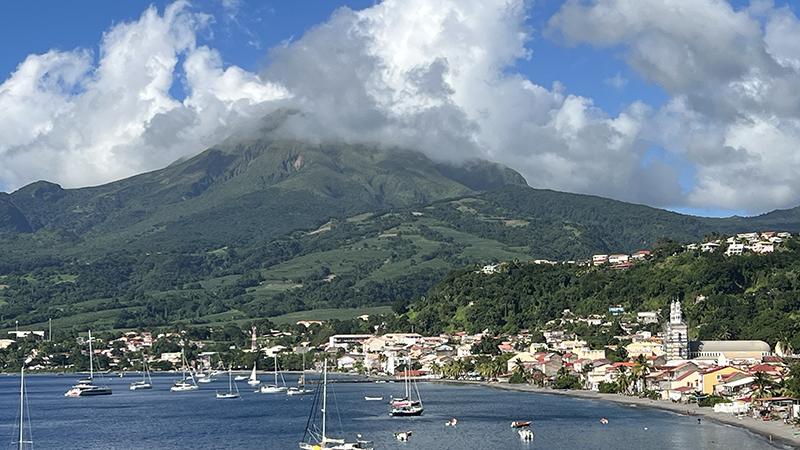
It was a quiet morning in May, 1902, and most residents of Saint-Pierre were likely having a little petit dejeuner. Shortly after 8 a.m. an angry mountain began spewing thick clouds of poisonous gas into the air. Andrew tells us red-hot, volcanic ash moved at speeds of nearly 200 mph. It reached Saint-Pierre in less than two minutes, leaving no time to prepare or react. The hot ash sparked firestorms. Buildings tumbled to the ground. Almost instantly, some 28,000-30,000 souls lie dead in their homes or on the street. Andrew relates a story that says the only survivor was a man named Louis-Auguste Cyparis, who was in the town’s prison after a drunken incident. Cyparis was in an underground cell when the volcano hit, which allowed him to live. The story goes that local nuns heard someone might still be alive in Saint-Pierre and came to his rescue. Cyparis later was given a circus job by P.T. Barnum, and paraded about as the lucky survivor of the terrible explosion in Martinique. Andrew tells us Cyparis later moved to Panama, came down with yellow fever, and died.
Today, they’re trying to rebuild Saint-Pierre but it’s a slow process. The stone buildings that once housed prosperous shops (many built on the awful slave trade) are still in ruins along the waterfront, with vivid green plants and small trees growing from the rock. There’s a museum where you can learn about the disaster. Today, Saint-Pierre has only 5,000 residents, Andrew says. If you’re on the island, it’s a don’t miss place that would welcome visitors who could buy a lunch or a small gift and boost the local economy.
A SOUTH ISLAND BEACH TOWN
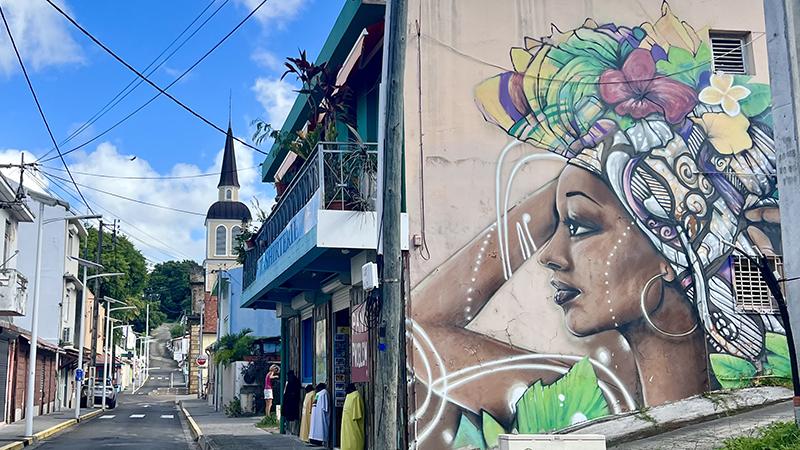
It’s only about a 20-minute walk from Club Med to the small waterfront town of Saint-Anne. The walk takes you along a fine, public beach with small, brightly coloured food shacks and a delightful, pale yellow post office building that’s practically built on the sand. The town has small souvenir and clothing shops, a pharmacy and a pretty church. When I wandered into town with a friend there was a tiny covered market selling brightly coloured sarongs, local spices and intricately carved gourds. It makes for a charming outing, and a lovely morning or late afternoon walk.
IF YOU GO
Full-day excursions with Top Tours Antilles are sold at Club Med for 145 Euros, including a nice lunch. Our group of four visitors had a full-size minivan. Club Med also offers half-day excursions and visits to other destinations.
MORE INFORMATION
Club Med Buccaneer’s Creek is a fine beach resort, and the only all-inclusive on the island.
For general visitor help, visit the Martinique Tourism site.

